1. Build your scene
This is really outside of this tutorial so only few hints.
As the first thing, open Document Tree editor (Dialogs -> Document Tree). It has property pages for the most of object types in scenes and most fine-tuning has to be done with it.
Add lights. It can be done later, but a good idea is to add at least one directional light as the first step (Objects -> Add -> Lights -> Directional Light) because otherwise model will look plain and it is hard to understand their poses exactly.
Import objects and figures (Objects -> Import). Currently there is support for most Illusion model formats (althoughthe ones from cell-shaded games do no look nice), MD5 (Doom3 and Quake4), OBJ, 3DS, Collada (partial) and Poser (partial) file formats.
Scale models. Default scales are mostly OK for Illusion, MD5 and Poser files, but the ones imported from other formats may be of very different scales. For scaling, select object (click on it when it has yellow highlight box) - the highlight box should turn orange. Now look at Document Tree dialog - either object of type Figure (poseable object) or StaticMesh (non-poseable) should be selected.
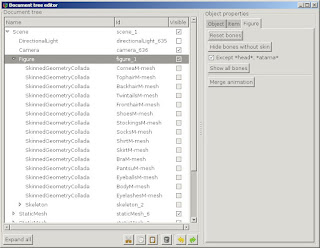 |
| Document tree showing selected figure |
Click on Geometry tab and there are controls applicable to all Geometry types, among others a scale spinner.
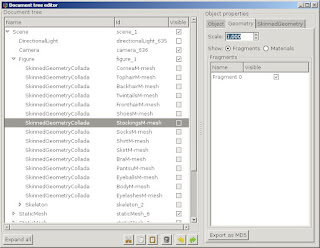 |
| Document tree with SkinnedGeometry selected Geometry property page open |
Place models. For this select model and transform control should appear. If it is not visible, try pressing Q key for few times - it cycles the control placement between object origin, object bounding box and the center of screen. Pressing SPACE key toggles between move and rotation controls. The same can be achieved with clicking on already selected model.
Take a look at hotkeys list (Help -> Hotkeys) - there are some useful keyboard and mouse hotkeys, like hiding controls temporarily and so on.
Pose figures - to do this, select figure (poseable object, like Illusion character, MD5 or Collada model) and choose skeleton tool from toolbar. If the selected object is of figure type, bluish skeleton should appear. Nothing will happen, if the object is not of posebale type.
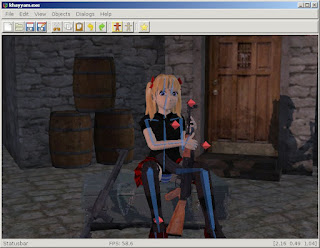 |
| Selected object with skeleton control |
Posing individual bones is quite similar to placing objects - although normally you do not want to move bones (it breaks body very unnaturally) but only rotate them.
Save scene. Save often, as Khayyam is still alpha and crashes a lot.
2. Set up lighting
Special lighting is the main reason you want to raytrace your scene. So take some time and try to set up lighting as well as possible - it really makes difference in final images.
Add spotlights (Objects -> Add -> Lights -> Spotlight). There can be practically unlimited number of spotlights, but they make rendering slower. Also semitransparent objects (hair) cannot currently be lighted by more than four spotlights.
Set light direction for spotlights. The easiest method to do this, is copying light direction from camera.
- Move camera to show the scene light you want it to be seen from the spotlight.
- From document tree select SpotLight node
- From right pane select Light tab
- Click From Camera button
- From the same place you can set the light intensity and color
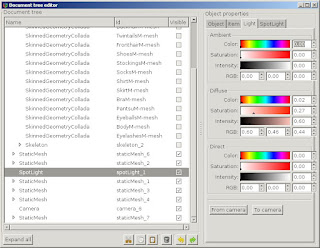 |
| Document tree with Spotlight selected and Light property page open |
Diffuse lighting determines the actual spotlight intensity and color.
Direct lighting if for specular highlights, but at moment it does not work reliably.
If you want to add light with soft shadows, use Area Lights. They are similar to spotlights, but are composed of many small lights on rectangular grid. Consequently they can slow down rendering quite a lot, so by default they only have 2 x 2 nodes. To achieve softer effect, you can add more sublights from document tree dialog.
3. Export scene to POV-Ray format
To export POV-Ray scene, select File -> Export POV-Ray Scene...
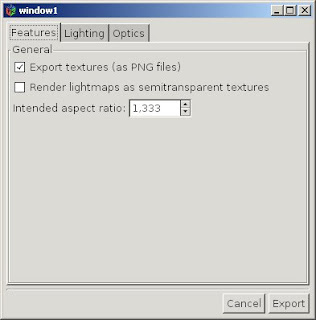 |
| POV-Ray export dialog |
If you have exported scene once and have not added any new objects to it, you can uncheck Export Textures as PNG files checkbox - this saves some exporter time, as it does not have to write texture files over and over.
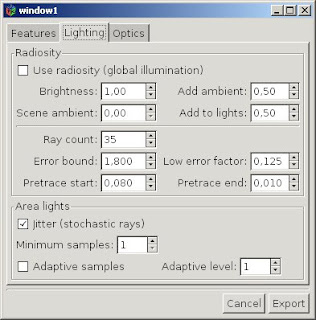 | |||
| Lighting properties from POV-Ray export dialog |
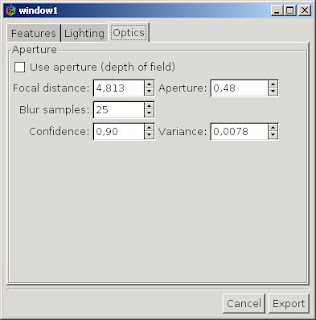 |
| Camera properties from POV-Ray export dialog |
Aperture makes rendered images much more photo-like and can add a lot to the mood. But it makes rendering slower.
Click Export and save file with the extension .pov. If you have already installed POV-Ray, it has registered itself as default handler for those file types.
4. Render it with POV-Ray
Using POV-Ray is outside this tutorial. Some hints though:
- POV-Ray opens all files in builtin editor, so to make small changes you do not have to re-export scene again.
- Rendering starts with button Run
- You can select render size from top-left menu box
- Render result will automatically be saved as png file to the same directory as pov file.
- POV-Ray uses custom scene description language that can be quite complex to understand.
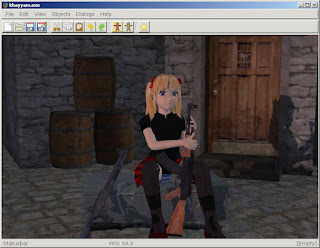 |
| Fully set up scene in Khayyam |
 |
| The same scene rendered with POV-Ray (using radiosity and aperture). As you can see, using radiosity added lot of extra light to environment. |
And this is it! Have fun!
دانلود آهنگ حسین تهی و امیر تتلو هلش دانلود آهنگ حسین تهی و امیر تتلو هلش (هولش) روز دنیا از اینجادانلود آهنگ جدید
ReplyDeleteدانلود آهنگ علی یاسینی چراغونی (گفته بودم بری زندگی نمیکنم یه روزم) دانلود آهنگ علی یاسینی چراغونی (گفته بودم بری زندگی نمیکنم یه روزم)
دانلود آهنگ جدید
very nice article thanks *_*
ReplyDeleteابی عالی مازرونی یار